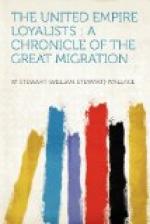Other motives influenced the growth of the Loyalist party. There were those who opposed the Revolution because they were dependent on government for their livelihood, royal office-holders and Anglican clergymen for instance. There were those who were Loyalists because they thought they had picked the winning side, such as the man who candidly wrote from New Brunswick in 1788, ’I have made one great mistake in politics, for which reason I never intend to make so great a blunder again.’ Many espoused the cause because they were natives of the British Isles, and had not become thoroughly saturated with American ideas: of the claimants for compensation before the Royal Commissioners after the war almost two-thirds were persons who had been born in England, Scotland, or Ireland. In some of the colonies the struggle between Whig and Tory followed older party lines: this was especially true in New York, where the Livingston or Presbyterian party became Whig and the De Lancey or Episcopalian party Tory. Curiously enough the cleavage in many places followed religious lines. The members of the Church of England were in the main Loyalists; the Presbyterians were in the main revolutionists. The revolutionist cause was often strongest in those colonies, such as Connecticut, where the Church of England was weakest. But the division was far from being a strict one. There were even members of the Church of England in the Boston Tea Party; and there were Presbyterians among the exiles who went to Canada and Nova Scotia. The Revolution was not in any sense a religious war; but religious differences contributed to embitter the conflict, and doubtless made Whigs or Tories of people who had no other interest at stake.
It is commonly supposed that the Loyalists drew their strength from the upper classes in the colonies, while the revolutionists drew theirs from the proletariat. There is just enough truth in this to make it misleading. It is true that among the official classes and the large landowners, among the clergymen, lawyers, and physicians, the majority were Loyalists; and it is true that the mob was everywhere revolutionist. But it cannot be said that the Revolution was in any sense a war of social classes. In it father was arrayed against son and brother against brother. Benjamin Franklin was a Whig; his son, Sir William Franklin, was a Tory. In the valley of the Susquehanna the Tory Colonel John Butler, of Butler’s Rangers, found himself confronted by his Whig cousins, Colonel William Butler and Colonel Zeb Butler. George Washington, Thomas Jefferson, John Adams, were not inferior in social status to Sir William Johnson, Thomas Hutchinson, and Joseph Galloway. And, on the other hand, there were no humbler peasants in the revolutionary ranks than some of the Loyalist farmers who migrated to Upper Canada in 1783. All that can be said is that the Loyalists were most numerous among those classes which had most to lose by the change, and least numerous among those classes which had least to lose.




